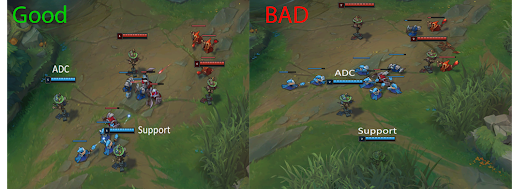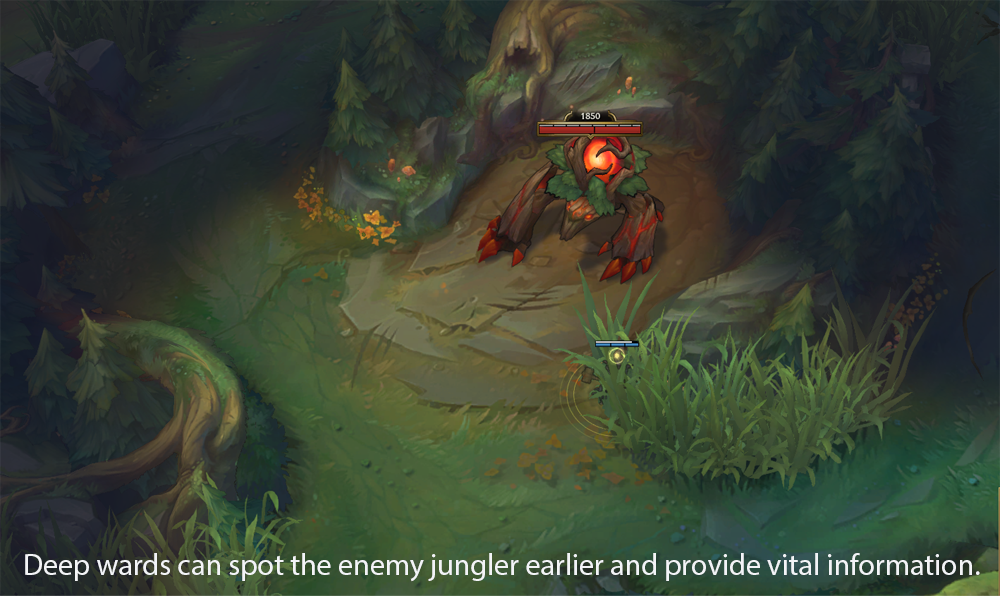Sometimes playing support in solo queue may seem like you are at the mercy of your teammates, and losses are just down to your team failing to capitalise on your perfect ward that spotted out the enemy team. But the only constant in every game is you! Finding out and correcting your mistakes is key to improving and winning more games.
This guide will help to point out the mistakes that you may be making unknowingly and provide solutions that will help you to become a better support.
MISTAKE #1: BAD POSITIONING IN LANE
Mistakes can happen as early as the first wave of the game, that is why the first thing to look out for in your games is your positioning during the laning phase. Poor positioning in lane is one of the most common mistakes support players make. Oftentimes you will see support players standing far behind their ADC or hiding in the bush doing nothing, essentially leaving their ADC vulnerable to an engage by the opponents. By standing behind your ADC, you are exerting zero pressure and allowing the enemy to have full control and priority over the lane.

Having lane priority basically means you have control over the lane and can rotate to objectives faster than the enemy laners can. Standing up front in the lane with your ADC is important, as it helps to exert pressure on the enemy bot lane and makes them think twice before engaging. Pressure can also force the enemy bot laners to back off, causing them to miss farm and giving you lane priority. Lane priority is extremely important, not just for keeping your ADC safe from poke and letting them farm happily, but it also allows for easy access to the river. Having easy river access opens up many options, such as placing deep wards in the enemy jungle, roaming to mid and rotating to help your jungler with objectives.
All of these benefits come from simply walking up with your ADC and making your presence felt. However, you may already be thinking in your mind, “But every time I walk up, I just get poked and lose all my health!” This is where factors such as the matchup need to be taken into consideration. For example, if you are playing Leona into Lux, you know that Lux has a massive range advantage over you. Your plan should be to hang back just outside of Lux’s Binding Light range or stand behind minions to block the root. Once Lux’s skills are on cooldown, you can look to engage or walk up to alleviate pressure from your ADC.
MISTAKE #2: NOT KNOWING HOW TO WARD EFFICIENTLY
Inefficient and wasteful warding is a mistake that can severely impact your team’s vision and could be a major reason why you are dying to ganks. When placing a ward down, it is extremely important to ensure that you get as much value as possible.
The picture above shows an example of good warding versus bad warding. The good ward is placed at the outer edge of the bush, giving full vision of the area between the tri-bush and the river. The bad ward on the other hand, fails to cover the wall surrounding the dragon pit, creating a tiny pocket of darkness. This may seem insignificant, however, players who are skilled will often hug the wall, as they know that players sometimes default to placing a lazy ward. This is an extremely destructive habit as it creates a false sense of security that could get you and your teammates killed.
Perhaps you have experienced this before: you look at the map, you see no one and think to yourself, “Coast is clear, time to engage!”. Next thing you know, the enemy jungler comes out of nowhere and BAM! They score a double kill and take dragon, leaving you scratching your head wondering how they got there. Ensuring your ward covers the entire entrance in an area is crucial, you should always be thinking about the value the ward is giving you.
Whenever supports and their ADC have lane priority and are farming under the enemy’s turret, some supports tend to default to lazy wards, such as warding the river bush or the tri-bush. But those wards will not save you from a Hecarim or Rammus running at the speed of light with Ghost activated. Instead, make full use of your lane priority, you could opt for deeper wards such as warding further up the river nearer to mid. If you are playing someone like a Pyke or a Bard who can disengage and run away easily, consider going into the enemy jungle and placing a deep ward down at their Red Buff. These wards are extremely powerful as they can help you to spot the enemy jungler far in advance, giving you and your ADC plenty of time to retreat. It could also indicate where the enemy jungler might be on the map.

Control Wards should be placed with even more care than normal wards. Unlike normal wards, Control Wards cost 75 gold and do not have stealth. They should be placed in areas where enemies are unlikely to check, or places where you can defend them easily if the enemies try to clear it. Oftentimes you will see support players waste their Control Ward, they might place a Control Ward down then recall back to base. Immediately after that, the enemy laners walk up and clear the ward, wasting their 75 gold and netting their opponents 30 gold in return. Objective control and vision denial is the main purpose of Control Wards. Limiting the amount of Control Wards you buy each game is also very important. Buying too many every game could be preventing you from hitting important item spikes and giving the opponents extra gold. Before an important objective like Baron or Dragon, buying a Control Ward and placing it near or inside the pit is extremely helpful for securing the objective. It hinders the opposing team’s chances of stealing the objective and forces them to walk in blindly if they choose to contest.
MISTAKE #3: NOT UNDERSTANDING PROPER WAVE MANAGEMENT
Thinking that only the ADC should attack the wave is a common misconception that many support players have. Learning proper wave management is essential to becoming a better support and helping your ADC make the right decisions.
One very common mistake supports make happens during the first two waves of minions. Supports tend to hang back and maybe look for some poke during the early stages of the laning phase. While looking to poke the enemy bot lane and exerting early pressure is good, supports usually do not think about hitting minions as the second wave is approaching. The reason for hitting the wave is so that you and your ADC can hit level two first, which allows you to either look for an early all in or force the opponents to back off. It is also important to not push the wave too much early on, as hitting level two first will not give you much of an advantage if the wave is too close to the enemy’s turret.
Not understanding proper wave management can also lead to you taking bad recalls. Here is a common situation that happens as a result of poor wave management: you and your ADC score a double kill in bot lane, now all you need to do is recall and spend your hard-earned gold, right? WRONG! You can extend your lead further by crashing the wave into the enemy’s turret, causing the enemy bot lane to lose experience and gold to their own turret. Because you crashed the wave into their turret, the wave is closer to the enemy’s side of the lane. This means that their next minion wave travels a shorter distance and will arrive to fight earlier than your minion wave, giving their wave an advantage. This causes the wave to naturally push back towards your side of the lane. By the time you and your ADC arrive back in lane, the wave will be closer to your turret, which forces the enemy bot lane to either walk to your side to farm, which makes them vulnerable to ganks, or hang back and give up experience and gold. Freezing waves could frustrate the opponents and force them to make a mistake, potentially allowing you to gain an advantage.
Knowing when to freeze and when to push the wave could be the difference between winning lane and having a miserable laning phase. Even if supports do not usually take the farm, knowing how to manage waves will certainly give you an advantage.
MISTAKE #4: CONSTANTLY FOLLOWING THE ADC
Another common mistake support players make is constantly sticking to their ADC. Although keeping your ADC safe is important, your job is to be a support for the entire team, not just for one player.
When the wave crashes into the enemy bot lane’s turret, support players should take this opportunity to establish vision control or look for plays elsewhere on the map. Staying in lane and helping your ADC siege will cause turret plating gold and any experience from incoming minion waves to be split between two people. This is not ideal as it causes your ADC to hit item and level spikes later than they should, which could be the difference between winning and losing any skirmishes that break out. There are certain exceptions to sieging; you may siege if it would mean that the turret will fall.
In cases where you lost the laning phase, following the ADC will cause them to lose experience and set them back even further behind. Instead, you should gravitate towards teammates that have a lead and help them to snowball further ahead. During the mid-game, support players may follow their jungler to make plays around the map. This is fine because jungle camps only give experience to the person that kills it, unlike lane minions which give experience to anyone in the vicinity.
MISTAKE #5: FOLLOWING BAD DECISIONS AND CALLS BY TEAMMATES DUE TO PRESSURE
This mistake is a little different compared to the others because it happens as a result of fear rather than a lack of game knowledge. Sometimes support players will follow up on bad calls and decisions by their team in an effort to please them or avoid flame. For example, a support sees their jungler and ADC go for a really bad dive under the enemy turret, and they know the play has no chance of succeeding. But because they are afraid of their teammates getting angry at them, they decide to follow the call and end up handing a triple kill over to the enemy bot lane. Their team might still get angry and blame somebody for misplaying, and that play ended up giving their opponents a bigger lead than it should have.
You cannot control the bad plays and decisions your teammates make, but you can always try to influence their decisions. By making it clear you have no intentions of following a call and pinging to back off, your teammates are more likely to think twice and back off than if you were to stay silent and follow them. Do not be afraid to be assertive and stick to what you know is right, even if your teammates might get a little annoyed by it.
CONCLUSION
League of Legends is an extremely in-depth game with lots of details to pay attention to, and there is always room for improvement and learning. Hopefully this guide has helped you to begin that process of becoming a better player!
All the best in your League of Legends journey and remember to have fun!


